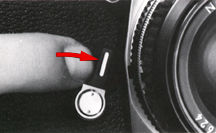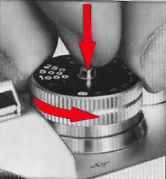The Nikon EL2 is an aperture-priority, automatic exposure control camera offering quite stable exposure accuracy with many lenses or accessories offer in the Nikon System. By means of its through-the-lens, center-weighted exposure metering system, the intensity of the light forming the image is precisely metered and converted into exposure data to control the camera's electronic shutter mechanism.
 |
The EL2's automation bypasses the necessity to match needles or calculate exposures. The photographer simply has to set the preferred lens aperture, focus, compose and then shoot. |
The EL2's automatic metering system opens the electronic shutter for precisely the time required to obtain a perfectly exposed photograph; shutter speeds range from an improved 8 to 1/1000 second (The later FE retained these settings, while it was an improvement from the original EL in 1972). Should the subject change position or the light vary, the EL2 will adjust the exposure to match: steplessly, instantly, automatically. Thus, the EL2 automatically eliminates the beginners or amateur's greatest stumbling block to more successful picture-taking and at the same time enables the professional to concentrate on the picture instead of on technicalities in the handling.
Should shutter speed priority operation be preferred, the photographer merely turns the aperture ring to maintain the dedicated shutter speed at the desired setting. As the camera's metering system reacts instantaneously to changes in aperture, the camera is always ready for action.
As there are few more options available
in the EL2 to work in conjunction with the automatic exposure, you can work either
singularly or in combinations to get a "higher" percentage of yield in
successful pictures: here they are for your reference:
Memory / AE (Auto Exposure) Lock
 |
For special photographic situations, such as backlit shots, the EL2's memory lock becomes invaluable. And it's simple to use. The photographer merely centers the subject, the face in a backlit shot, for example, in the 12mm diameter circle on the focusing screen. |
By merely pushing the self-timer lever in towards the lens, the one "locks" the meter reading to give the theoretically correct exposure for this selected part of the scene, one can recompose the picture, still keeping the memory lock depressed, and make the exposure. However, the meter needle is not locked during this procedure, but continues to follow the changes in light intensity even the AE lock is activated. The EL2 instantly reverts to normal automatic operation when the lever is released, thus eliminating any possibility of accidentally retaining the compensation factor and ruining subsequent exposures.
Exposure Compensation Ring.
| Sequence shooting, either by hand or with the EL2's companion AW-1 Auto Winder, may require a different kind of exposure compensation control for backlit shots or special photographic effects. The EL2 is also equipped with an exposure compensation ring which provides convenient dial-in exposure compensation factors of between -1 and +2 EV (one stop underexposure to two stops overexposure), which should be more than enough for most picture-taking situations (but certain highlight or low key pictures may require more than two: well, you can still adjust the ASA to fool the camera circuitry..hehe.). |
|
Manual Control.
If it comes to worst, while automatic operation is unquestionably the most convenient and fastest way to take pictures, there are times when the photographer may want to control the exposure himself. He may choose a fast shutter speed to 'freeze' the subject's motion when it is traveling at high speed, for example, or, conversely, he may deliberately blur the picture by using a slow shutter speed. The EL2 allows for this, of course, via full manual control which is readily available. This is why the EL2 has the edge over the mechanical counterparts, it encompasses what the mechanical Nikkormat F does, and has the option to be more responsive with the auto mode.
 |
  |
Deliberate over- or underexposure control in the manual mode. |
What you need to do is just depresses
the locking button in the center of the shutter-speed dial and rotate the dial until
the desired shutter speed is set. The shutter speed selected will be shown by the
green indicator in the viewfinder. When the shutter speed is set, the exposure can
be determined by moving the aperture ring until the black meter needle coincides
with the green/match needle operation. This technique should also be used for stop-down
metering with lenses or accessories that do not couple to the camera's metering system.
With manual operation, the photographer can choose freely from the 14 shutter speed settings from 8 to 1/1000
sec., each electronically
timed for outstanding accuracy, plus 'B' for longer-duration exposures, manually
timed. Flash photography is another field that requires manual control, and the EL2's
high flash sync speed of 1/125 sec. is especially well supplementing the Nikon F
or Nikon
F2's slower sync speed.
Basic Operation | Shutter Mechanism | Lens Mount | Exposure Control Viewfinder info | Metering | Flash | Film Advance (Auto) / Transport |
|
| Back | to Index Page of Nikkormats EL2
| Back | to
Main Index Page of Nikkormats EL Series
|
Back | to
Main Index Page of Nikkormat/Nikomat

Nippon
Kogaku KK Rangefinder
RF-Nikkor
lenses:-
Main Index Page
Nikon
Auto
Focus
Nikkor lenses:- Main Index Page
Nikon
Manual
Focus
Nikkor lenses-
Main Index Page
Fisheye-Nikkor Lenses - Circular | Full Frame |
Ultrawides Lenses - 13mm15mm18mm20mm | Wideangle Lenses - 24mm28mm35mm |
Standard Lenses - 45mm 50mm 58mm | Telephoto
Lenses - 85mm105mm135mm180mm & 200mm |
Super-Telephoto
Lenses - 300mm 400mm 500mm 600mm 800mm 1200mm |
Special
Application lenses:
Micro-Nikkor Lenses - 50mm~55mm -60mm 85mm -105mm 200mm Micro-Zoom 70-180mm
Perspective Control (PC) - 28mm 35mm
PC-Micro 85mm
Dedicated
Lenses for Nikon F3AF: AF 80mm f/2.8 | AF 200mm f/3.5 EDIF
Depth
of Field Control (DC): 105mm 135mm
Medical
Nikkor: 120mm 200mm
Reflex-Nikkor Lenses - 500mm 1000mm 2000mm
Others:
Noct Nikkor |
OP-Nikkor | UV Nikkor 55mm 105mm |
Focusing Units | Bellows-Nikkor 105mm 135mm
Nikon
Series
E Lenses:
28mm35mm50mm100mm135mm |
E-Series Zoom lenses: 36~72mm75~150mm70~210mm
MF Zoom-Nikkor Lenses: 25~50mm | 28~45mm | 28~50mm | 28~85mm | 35~70mm | 36~72mm E | 35~85mm | 35~105mm | 35~135mm |
35~200mm | 43~86mm | 50~135mm | 50~300mm | 70~210mm E | 75~150mm E | 80~200mm | 85~250mm |
100~300mm | 180~600mm | 200~400mm | 200~600mm | 360~1200mm | 1200~1700mm
Tele-Converters: TC-1 | TC-2 | TC-200 | TC-201 | TC-300 | TC-301 | TC-14 | TC-14A | TC-14B | TC-14C | TC-14E | TC-16 | TC-16A | TC-20E
![]()
Nikon F
| Nikon F2 |
Nikon
F3
| Nikon F4 |
Nikon
F5
| Nikon F6 |
Nikkormat / Nikomat |
Nikon FM
| Nikon FE/ FA | Nikon EM/FG/FG20 | Nikon Digital SLRs | Nikon - Other models
MIR Supports for Photographic Community: Various Message Boards/Community
Forums
Nikon
F-series|
Nikon
F2-series|
Nikon
F3-series|
Nikon F4-series| Nikon
F5-series|Nikkormat/Nikomat-series
Nikon FM-series|Nikon
FE-series|Nikon
FA|Nikon
Digital
SLR
series|Various
Nikon
Models|Nikkor
Optic
-shared
Others:- Free Trade Zone - Photography| Free Trade Zone - Business Community |Free To Zouk - Photographic Community
Apple's Mac Public Community Message Board | Windows based PC &
Apple/Mac
Public Community Trade Exchange Centre
Recommended links to understand
more technical details related to the Nikkor F-mount and production Serial Number:
http://rick_oleson.tripod.com/index-153.html by: my friend, Rick Oleson
http://www.zi.ku.dk/personal/lhhansen/photo/fmount.htm by: Hansen, Lars Holst
http://www.mir.com.my/rb/photography/hardwares/nikonfmount/lens2.htm
http://www.photosynthesis.co.nz/nikon/serialno.html
About
this photographic
site.
Home - Photography
In Malaysia
![]()
Copyright
© 1998.
HIURA Shinsaku ® ; Nikomat ML, Japan,
in collaboration with leofoo ®. MIR Web Development Team.
* Credit: A
Great thanks to Mr Denis Pleic for his volunteering
effort to reedit content and and patching some grammatical mistakes found in this
section of the PIM site. Miss
Rissa (Marketing) & Edward
(Techical) of Shriro Malaysia, distributor of Nikon cameras in Malaysia, in providing
so many useful inputs to make this site possible. Mr Hong,
Ipoh for lending me his FT2 to take some of the images used in this site. This site
is created for his eldest son, Yuen who has picked up his father's hobby and
the FT-2. My friend, John Walls from Florida, US for his images of the FTn
body and the Zoom Nikkor
43-86mm.
[Left Brain][Right brain][Home-MIR]
[Invention][Art & Design][Clubs]
[Portfolios][On assignments]
[Trading
room][Knowledge
& Resources]
[Free-trade-zone][Thoughts & opinions][Links]

